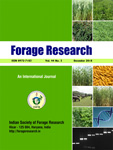POOJA GUPTA SONI*, SARITA RANI, SATPAL, PARAS KAMBOJ, ROOHI, RAVISH PANCHTA AND KRISHAN KUMAR
Department of G&PB (Forage Section), Department of Soil Science, Department of Agronomy
CCS Haryana Agricultural University, Hisar-125 004 (Haryana), India
IARI-Krishi Vigyan Kendra, Shikohpur, Gurugram-122 004 (Haryana), India
*(e-mail: poojagupta.agri@gmail.com)
(Received: 2 June 20225; Accepted: 28 June 2025)
SUMMARY
Fodder crops are essential to agriculture because they are grown mainly for animal feed. These crops, which include legumes and grasses, are essential to keeping animals’ diets steady and wholesome. One of the main causes of the cattle population’s low productivity is the lack of enough feed and fodder resources. In India green fodder, dry fodder, and feed concentrate are currently in low supply to the tune of 11.23, 23.40 and 28.90%, respectively. A major problem in agriculture, weeds lower crop productivity and quality, including fodder crops, and result in large financial losses. They are one of the major biotic constraints in agricultural production. Fodder crops, such as alfalfa, clover, and various grasses, are integral to livestock farming as they provide essential nutrition for animals. However, weed infestation significantly hampers fodder yield and quality by competing for nutrients, water, light, and space. Effective weed management is vital to ensure optimal fodder crop productivity. This review presents an overview of weed problems in cultivated fodder crops, evaluates various weed management strategies including cultural, mechanical, chemical, and integrated approaches and outlines future research priorities.
Key words: Berseem, fodder, maize, sorghum, weed management

